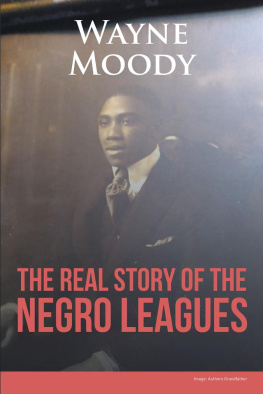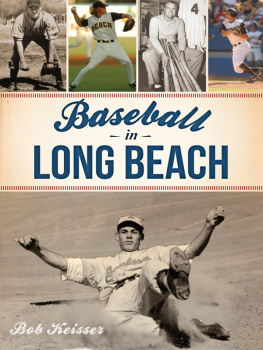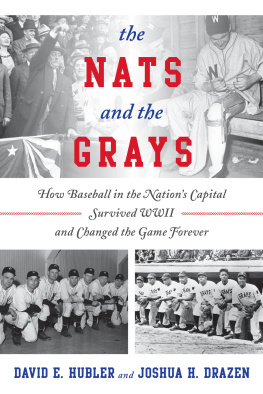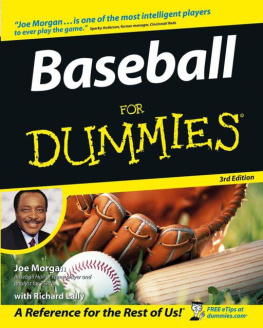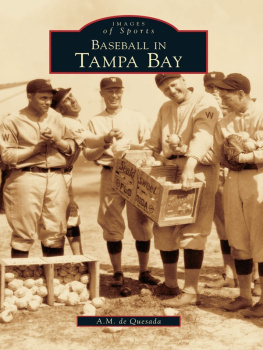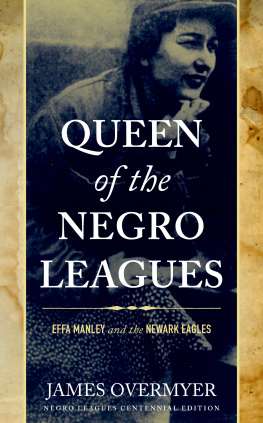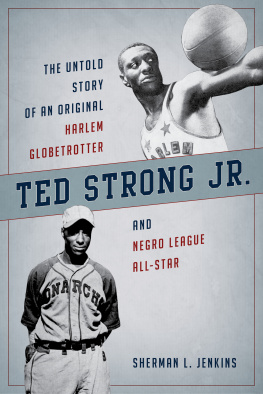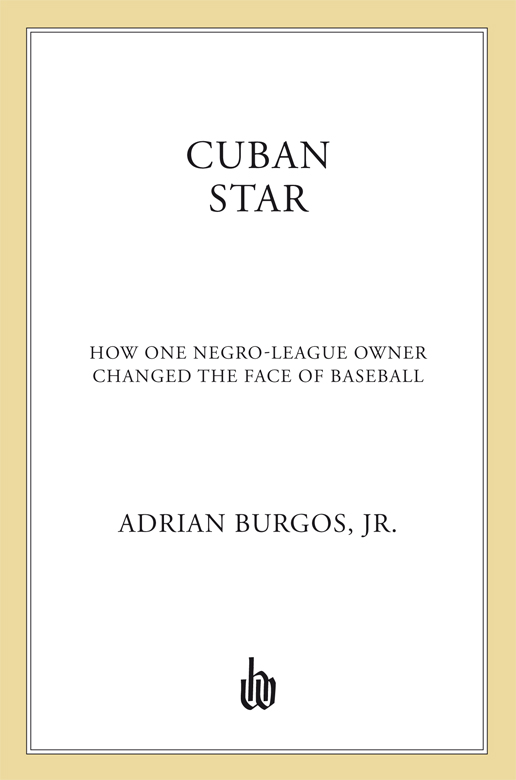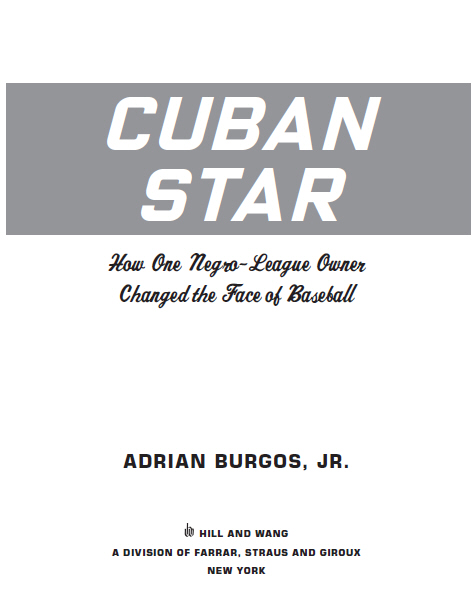
To Dolly, Miranda, and Julia
CONTENTS
PREFACE
Some stories seemingly wait for specific historians to uncover, research, and write. For me it was the life of Alex Pompez, the Harlem numbers king who became professional baseballs greatest importer of Latin American talent. His burial plot in the expansive Woodlawn Cemetery was right across the street from the Bronx apartment where my maternal grandmother lived. Woodlawns marvelous headstones, family crypts, and mausoleums long intrigued me. On childhood visits to my grandmothers apartment I often gazed into the cemetery and wondered about the life stories of those buried there: war heroes who date back to the American Revolution, New York Citys well-known families, along with the famous entertainers Irving Berlin, George M. Cohan, and Duke Ellington and the historical figures Elizabeth Cady Stanton and Madame C. J. Walker. Most of their stories have been told. The story of Pompez, one of Woodlawns lesser-known occupants, piqued my curiosity.
His life story embodied both the dreams deferred and the promise of Americas game with a twist. He was an Afro-Cuban-American who rose to reign as a Harlem numbers king and then remade himself strictly as a baseball entrepreneur and talent evaluator of the highest order. I became acutely aware of Pompezs contribution to baseball history while researching my first book on how Latinos were affected by baseballs color line. Interestingly, his role had typically been described as part of two distinct chapters, as if his story didnt bridge the era of Jim Crow segregation and the onset of baseball integration. In fact, his name kept popping up in three discrete historical literatures: Negro leagues, Latinos in baseball, and Harlem. Yet the dots were never fully connected. As I eventually discovered, the story of his forebears and his time in Harlem threaded these stories together and illuminated the forces and actors who shaped who he was and how he became baseballs numbers king.
Pompez was a trailblazer who over the span of seven decadesfrom his Negro-league days through his major-league scouting workopened pathways for talent from once-insignificant baseball territories. His Cuban Stars were the first Negro-league team to tour Puerto Rico and the Dominican Republic, and they were also the first to acquire talent from these two baseball-loving societiesdecades before the major leagues dipped into these talent pools. Equally significant, his approach to the incorporation of individuals from these and other Spanish-speaking societies in the 1950s and 1960s prefigured the best practices major-league teams would adopt in the late twentieth century: Spanish-language classes in spring training, formal and informal mentoring, and careful selection of housing for young players, among others.
This book provides an inside look at the sporting world and communities within which Pompez operated. His story not only complicates how most scholars have written about race in America and the working of the color linewhat the African American intellectual W.E.B. DuBois astutely predicted would be the problem of the twentieth centurybut also what we think we know about the process of dismantling baseballs color line. Simply put, many did not quite know what to do with the fact that he was a black Latino, a mulatto who was bilingual. Attempts to place his story within traditional notions of race and identity led to a conundrum: Was it a story of a Cuban, a black man, an American, or some combination of the three? Historians have also not fully explored the people, events, and circumstances that shaped who Pompez was as a man. This book unravels much of the mystery that surrounds his time in Harlems numbers racket, his work as a sports entrepreneur, and his involvement in the desegregation of organized baseball. His story is of an individual who lived in between what others viewed and some sought to maintain as well-defined spaces: black-white; legal-illegal; good-criminal; citizen-foreigner. He was all of these, often at the same time.
* * *
On February 27, 2006, the Baseball Hall of Fame announced that Pompez, along with sixteen other Negro-league figures, had been selected for induction by a special Negro-league committee. His election meant he would have a plaque among baseballs immortals in the Hall of Fame gallery, joining the handful of players whose careers he had touched: Orlando Cepeda, Martn Dihigo, Monte Irvin, Willie McCovey, Juan Marichal, and Willie Mays.
I had the distinct honor of serving on the committee that elected Pompez to this hallowed hall. Only a select few Latinos are immortalized in Cooperstown, from both baseballs segregated and integrated eras. He actually bridges the two eras, capturing the story of baseballs color line and those who finally traversed it. Pompez was a Negro-league team owner, briefly NNL (Negro National League) vice president, and a major-league scout who became the first Latino director of international scouting for any organization, and his story encapsulates the arc of race, opportunity, and Americas game. As someone who was black and Latino, he encountered race in nearly all of its complexities when it came to baseball in the Americas. That racial beliefs followed wherever he traveled and persisted regardless of his station in life is captured in former Cuban baseball team owner Emilio de Armass description of Pompez to the journalist Robert Heuer: l era mulatto, pero todova era buena gente (He was black, but he was still a good person). Such comments were often standard fare, not extraordinary expressions of personal animus or racial hatred. The words remind us that leaving the United States for the Spanish-speaking Caribbean did not mean Pompez entered into a race-free zone, lands where all were color-blind and race neutral; that place did not exist then, nor does it now. This reality did not sour him. Most who knew him recall his warm smile, endearing personality, and determination, qualities that convinced most prospects and parents to place their trust in him.
The once-excluded Negro-league executive made the smoothest transition of all Negro-league owners to baseballs integrated era. He was much more than an evaluator of talent who scouted Latin America and the black baseball circuit for the Giants. A witness to the rise and fall of the Negro leagues, the hardening of racial fault lines in the American South, the limitations of color blindness within the Cuban nation-building project, and the harsh realities of both southern and northern forms of segregation, he drew on this vast experience to counsel African American and Latino prospects about the rules of social engagement. This represents an understudied part of baseballs integration story: the unique expertise honed through involvement in the Negro leagues and Caribbean baseball brought to bear on the entry and development of black and Latino players into organized baseball. Indeed, over his twenty-five years with the Giants, his recommendations spurred the organization to acquire the Negro-league stars Monte Irvin and Willie Mays while personally participating in the signing of McCovey, Cepeda, and Marichal.
He never fully escaped his past as a numbers king, however. His inclusion in the Hall of Fames 2006 class had its dissenters. Some stated that his reign as a Harlem numbers king while a Negro-league owner should have disqualified him. A Kansas Citybased sportswriter decried him as a notorious mobster, a racketeer, a member of Schultzs mob, and the No. 1 numbers man in Harlem. To such dissenters, that period in his life forever constrains the possibility of his redemption. In their view numbers kings were vultures who preyed on the dreams of the less fortunate in Harlems black and Latino communities; a few attached that label to Pompez and his baseball career, claiming he also took advantage of the baseball aspirations of Latinos for his own gain. Grave inconsistency, complained some baseball enthusiasts, especially since the major leagues all-time hit leader, Pete Rose, remained permanently ineligible due to his gambling on baseball. A reflection of the hobgoblin of consistency in Hall of Fame elections historically, wrote noted baseball historian John Thorn in a New York Times op-ed piece of Pompezs election while Rose remained barred. Other dissenters disputed his impact within baseball, minimizing his contribution to two of the more significant transformations in U.S. professional baseball during the twentieth century: its integration and its Latinoization.




